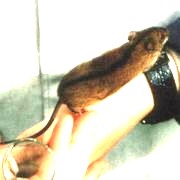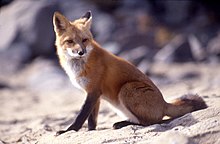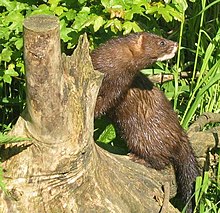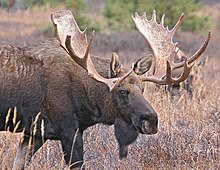List of mammals of South Ossetia
This is a list of the mammal species recorded in South Ossetia.[1]
The following tags are used to highlight each species' conservation status as assessed by the International Union for Conservation of Nature:
| EX | Extinct | No reasonable doubt that the last individual has died. |
| EW | Extinct in the wild | Known only to survive in captivity or as a naturalized populations well outside its previous range. |
| CR | Critically endangered | The species is in imminent risk of extinction in the wild. |
| EN | Endangered | The species is facing an extremely high risk of extinction in the wild. |
| VU | Vulnerable | The species is facing a high risk of extinction in the wild. |
| NT | Near threatened | The species does not meet any of the criteria that would categorise it as risking extinction but it is likely to do so in the future. |
| LC | Least concern | There are no current identifiable risks to the species. |
| DD | Data deficient | There is inadequate information to make an assessment of the risks to this species. |
Some species were assessed using an earlier set of criteria. Species assessed using this system have the following instead of near threatened and least concern categories:
| LR/cd | Lower risk/conservation dependent | Species which were the focus of conservation programmes and may have moved into a higher risk category if that programme was discontinued. |
| LR/nt | Lower risk/near threatened | Species which are close to being classified as vulnerable but are not the subject of conservation programmes. |
| LC | Lower risk/least concern | Species for which there are no identifiable risks. |
Order: Rodentia (rodents)
[edit]


- Suborder: Sciurognathi
- Family: Sciuridae (squirrels)
- Subfamily: Sciurinae
- Tribe: Sciurini
- Genus: Sciurus
- Caucasian squirrel, S. anomalus LC
- Genus: Sciurus
- Tribe: Sciurini
- Subfamily: Xerinae
- Tribe: Marmotini
- Genus: Spermophilus
- Caucasian mountain ground squirrel, Spermophilus musicus LC
- Little ground squirrel, Spermophilus pygmaeus LC
- Genus: Spermophilus
- Tribe: Marmotini
- Subfamily: Sciurinae
- Family: Gliridae (dormice)
- Subfamily: Leithiinae
- Genus: Dryomys
- Forest dormouse, Dryomys nitedula LR/nt
- Genus: Dryomys
- Subfamily: Glirinae
- Genus: Glis
- European edible dormouse, Glis glis LR/nt
- Genus: Glis
- Subfamily: Leithiinae
- Family: Dipodidae (jerboas)
- Subfamily: Allactaginae
- Genus: Allactaga
- Small five-toed jerboa, Allactaga elater LC
- Genus: Allactaga
- Subfamily: Sicistinae
- Genus: Sicista
- Northern birch mouse, Sicista betulina LR/nt
- Caucasian birch mouse, Sicista caucasica LC
- Kazbeg birch mouse, Sicista kazbegica DD
- Genus: Sicista
- Subfamily: Allactaginae
- Family: Cricetidae
- Subfamily: Cricetinae
- Genus: Cricetus
- European hamster, Cricetus cricetus LC
- Ciscaucasian hamster, Mesocricetus raddei LC
- Genus: Cricetus
- Subfamily: Arvicolinae
- Genus: Chionomys
- Caucasian snow vole, Chionomys gud LR/nt
- Robert's snow vole, Chionomys roberti LR/nt
- Genus: Ellobius
- Transcaucasian mole vole, Ellobius lutescens LC
- Genus: Microtus
- Altai vole, Microtus obscurus LC
- Genus: Chionomys
- Subfamily: Cricetinae
- Family: Muridae (mice, rats, voles, gerbils, hamsters, etc.)
- Subfamily: Murinae
- Genus: Apodemus
- Striped field mouse, Apodemus agrarius LC
- Yellow-breasted field mouse, Apodemus fulvipectus LC
- Black Sea field mouse, Apodemus ponticus LC
- Ural field mouse, Apodemus uralensis LC
- Genus: Micromys
- Harvest mouse, Micromys minutus LR/nt
- Genus: Apodemus
- Subfamily: Murinae
- Family: Sciuridae (squirrels)
Order: Erinaceomorpha (hedgehogs and gymnures)
[edit]The order Erinaceomorpha contains a single family, Erinaceidae, which comprise the hedgehogs and gymnures. The hedgehogs are easily recognised by their spines.
- Family: Erinaceidae (hedgehogs)
- Subfamily: Erinaceinae
- Genus: Erinaceus
- Southern white-breasted hedgehog, Erinaceus concolor LC
- Genus: Erinaceus
- Subfamily: Erinaceinae
- Family: Erinaceidae (hedgehogs)
Order: Soricomorpha (shrews, moles, and solenodons)
[edit]
The Soricomorpha are insectivorous mammals. The shrews and solenodons resemble mice.
- Family: Soricidae (shrews)
- Subfamily: Crocidurinae
- Genus: Crocidura
- Gueldenstaedt's shrew, Crocidura gueldenstaedtii LC
- Bicolored shrew, Crocidura leucodon LC
- Lesser white-toothed shrew, Crocidura suaveolens LC
- Tribe: Soricini
- Genus: Sorex
- Eurasian pygmy shrew, Sorex minutus LC
- Radde's shrew, Sorex raddei LC
- Caucasian pygmy shrew, Sorex volnuchini LC
- Genus: Sorex
- Genus: Crocidura
- Subfamily: Crocidurinae
- Family: Soricidae (shrews)
Order: Chiroptera (bats)
[edit]
The bats' most distinguishing feature is that their forelimbs are developed as wings, making them the only mammals capable of flight.
- Family: Vespertilionidae
- Subfamily: Myotinae
- Genus: Myotis
- Bechstein's bat, Myotis bechsteini VU
- Lesser mouse-eared bat, Myotis blythii LC
- Geoffroy's bat, Myotis emarginatus VU
- Natterer's bat, Myotis nattereri LC
- Genus: Myotis
- Subfamily: Vespertilioninae
- Genus: Barbastella
- Barbastelle, Barbastella barbastellus VU
- Genus: Eptesicus
- Northern bat, Eptesicus nilssoni LC
- Genus: Nyctalus
- Greater noctule bat, Nyctalus lasiopterus LR/nt
- Lesser noctule, Nyctalus leisleri LR/nt
- Genus: Pipistrellus
- Nathusius' pipistrelle, Pipistrellus nathusii LC
- Genus: Plecotus
- Brown long-eared bat, Plecotus auritus LC
- Genus: Barbastella
- Subfamily: Miniopterinae
- Genus: Miniopterus
- Schreibers' long-fingered bat, Miniopterus schreibersii LC
- Genus: Miniopterus
- Subfamily: Myotinae
- Family: Rhinolophidae
- Subfamily: Rhinolophinae
- Genus: Rhinolophus
- Mediterranean horseshoe bat, Rhinolophus euryale VU
- Greater horseshoe bat, Rhinolophus ferrumequinum LR/nt
- Lesser horseshoe bat, Rhinolophus hipposideros LC
- Mehely's horseshoe bat, Rhinolophus mehelyi VU
- Genus: Rhinolophus
- Subfamily: Rhinolophinae
- Family: Vespertilionidae
Order: Carnivora (carnivorans)
[edit]

The majority of the species of carnivorans feed primarily on meat. They have a characteristic skull shape and dentition.
- Suborder: Feliformia
- Family: Felidae (cats)
- Subfamily: Felinae
- Genus: Felis
- Wildcat, Felis silvestris LC
- Genus: Lynx
- Eurasian lynx, Lynx lynx NT
- Genus: Felis
- Subfamily: Pantherinae
- Subfamily: Felinae
- Family: Felidae (cats)
- Suborder: Caniformia
- Family: Canidae (dogs, foxes)
- Family: Ursidae (bears)
- Genus: Ursus
- Brown bear, Ursus arctos LC
- Genus: Ursus
- Family: Mustelidae (mustelids)
- Genus: Mustela
- Stoat, Mustela erminea LC
- Steppe polecat, Mustela eversmannii LC
- European mink, Mustela lutreola EN
- Least weasel, Mustela nivalis LC
- Genus: Vormela
- Marbled polecat, Vormela peregusna LC
- Genus: Martes
- Beech marten, Martes foina LC
- Pine marten, Martes martes LC
- Genus: Meles
- Caucasian badger, M. canescens NE
- Genus: Lutra
- European otter, Lutra lutra NT
- Genus: Mustela
- Family: Phocidae (earless seals)
- Genus: Monachus
- Mediterranean monk seal, Monachus monachus CR
- Genus: Monachus
Order: Artiodactyla (even-toed ungulates)
[edit]
The even-toed ungulates are ungulates whose weight is borne about equally by the third and fourth toes, rather than mostly or entirely by the third as in perissodactyls.
- Family: Cervidae (deer)
- Subfamily: Cervinae
- Subfamily: Capreolinae
- Genus: Alces
- Moose, A. alces LC extirpated
- Caucasian moose, A. a. caucasicus EX
- Moose, A. alces LC extirpated
- Genus: Alces
- Family: Bovidae (bovids)
- Subfamily: Caprinae
- Genus: Capra
- Wild goat, C. aegagrus NT
- West Caucasian tur, C. caucasica EN
- East Caucasian tur, C. cylindricornis VU
- Genus: Ovis
- Argali, O. ammon NT
- Genus: Rupicapra
- Chamois, R. rupicapra LC
- Genus: Capra
- Subfamily: Caprinae
See also
[edit]Notes
[edit]- ^ This list is derived from the IUCN Red List which lists species of mammals and includes those mammals that have been classified as recently extinct (since 1500 AD). The taxonomy and naming of the individual species is based on those used in existing Wikipedia articles as of 21 May 2007 and supplemented by the common names and taxonomy from the IUCN, Smithsonian Institution, or University of Michigan where no Wikipedia article was available.
References
[edit]- "The IUCN Red List of Threatened Species". IUCN. 2001. Retrieved 22 May 2007.[dead link]
- "Mammal Species of the World". Smithsonian National Museum of Natural History. 2005. Archived from the original on 27 April 2007. Retrieved 22 May 2007.
- "Animal Diversity Web". University of Michigan Museum of Zoology. 1995–2006. Retrieved 22 May 2007.
